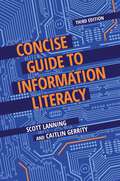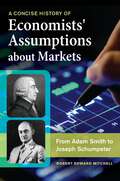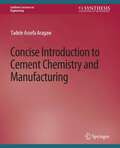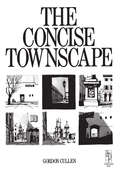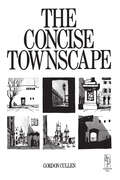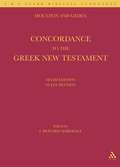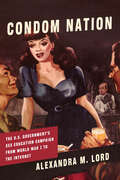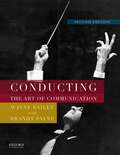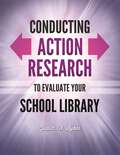- Table View
- List View
Concise Guide to Information Literacy
by Scott Lanning Caitlin GerrityThis flexible text can serve as the basis of a course in information literacy or as a supplemental text or basic research guide in any course.Both a students' textbook and an instructional reference for educators, this brief but information-rich text teaches students what information literacy is and why it's such an important skill to develop. Authors Scott Lanning and Caitlin Gerrity concentrate on developing skills and behaviors that positively impact the information literacy process. They teach such skills as evaluating and using information and behaviors like exploring, analyzing, and creating.Updated to incorporate the new AASL standards, this third edition of Concise Guide to Information Literacy includes new information on the value of curiosity and choice in the research process, offers a new model of the research process (the Reflective Inquiry Model), and updates the Decision Points Information Seeking Model that describes how student researchers choose to use the information they've found. This book has proven to be invaluable for high school and college students learning about information literacy and librarians and teachers in upper high school and community college settings.
A Concise Guide to Opioid Addiction for Counselors
by Kevin G. Alderson Samuel T. GladdingThis brief, evidence-based guide is ideal for busy mental health professionals helping clients with opioid use disorders (OUDs). It examines the devastating global impact caused by opioids and is replete with information and resources that can be immediately applied to addiction work. The authors’ pragmatic, strengths-based approach to treatment is based on a collaborative counselor-client working alliance to achieve client readiness for change, moderation, and abstinence. Topics discussed include current research on risk and protective factors, OUD assessment and diagnosis, the ethical and legal issues particular to addiction work, medication-assisted treatment, physical and psychological interventions for pain management, and the necessity of interdisciplinary care. In addition, Drs. Alderson and Gladding provide a number of counseling approaches and treatment options that consider work with women, youth, people of color, LGBTQ+ individuals, veterans, older adults, people with disabilities, individuals in the criminal justice system, and rural residents. Five useful appendices conclude the book, including a listing of 20 opioid drugs in descending order of potency; common ICD-10, ICD-10-CM, and ICD-11 codes; and a glossary of terms and abbreviations *Requests for digital versions from ACA can be found on www.wiley.com. *To purchase print copies, please visit the ACA website here *Reproduction requests for material from books published by ACA should be directed to permissions@counseling.org
A Concise Guide to Opioid Addiction for Counselors
by Kevin G. Alderson Samuel T. GladdingThis brief, evidence-based guide is ideal for busy mental health professionals helping clients with opioid use disorders (OUDs). It examines the devastating global impact caused by opioids and is replete with information and resources that can be immediately applied to addiction work. The authors’ pragmatic, strengths-based approach to treatment is based on a collaborative counselor-client working alliance to achieve client readiness for change, moderation, and abstinence. Topics discussed include current research on risk and protective factors, OUD assessment and diagnosis, the ethical and legal issues particular to addiction work, medication-assisted treatment, physical and psychological interventions for pain management, and the necessity of interdisciplinary care. In addition, Drs. Alderson and Gladding provide a number of counseling approaches and treatment options that consider work with women, youth, people of color, LGBTQ+ individuals, veterans, older adults, people with disabilities, individuals in the criminal justice system, and rural residents. Five useful appendices conclude the book, including a listing of 20 opioid drugs in descending order of potency; common ICD-10, ICD-10-CM, and ICD-11 codes; and a glossary of terms and abbreviations *Requests for digital versions from ACA can be found on www.wiley.com. *To purchase print copies, please visit the ACA website here *Reproduction requests for material from books published by ACA should be directed to permissions@counseling.org
A Concise Guide to Teaching With Desirable Difficulties (Concise Guides To College Teaching And Learning Ser.)
by Diane Cummings Persellin Mary Blythe DanielsThis concise guidebook on desirable difficulties is designed to be a resource for academics who are interested in engaging students according to the findings of peer-reviewed literature and best practices but do not have the time to immerse themselves in the scholarship of teaching and learning.Intentionally brief, the book is intended to: summarize recent research on five aspects of desirable difficulties; provide applications to the college classroom based on this research; include special sections about teaching strategies that are based on best practices; and offer annotated bibliographies and important citations for faculty who want to pursue additional study. The book will provide a foundation for instructors to teach using evidence-based strategies that will strengthen learning and retention in their classrooms.In addition to chapters on the desirable difficulties, the book also includes chapters on teaching first-year and at-risk students to embrace this approach, on negotiating student resistance, and on using this approach in teaching online.
A Concise Guide to Teaching With Desirable Difficulties
by Diane Cummings Persellin Mary Blythe DanielsThis concise guidebook on desirable difficulties is designed to be a resource for academics who are interested in engaging students according to the findings of peer-reviewed literature and best practices but do not have the time to immerse themselves in the scholarship of teaching and learning.Intentionally brief, the book is intended to: summarize recent research on five aspects of desirable difficulties; provide applications to the college classroom based on this research; include special sections about teaching strategies that are based on best practices; and offer annotated bibliographies and important citations for faculty who want to pursue additional study. The book will provide a foundation for instructors to teach using evidence-based strategies that will strengthen learning and retention in their classrooms.In addition to chapters on the desirable difficulties, the book also includes chapters on teaching first-year and at-risk students to embrace this approach, on negotiating student resistance, and on using this approach in teaching online.
A Concise Guide to Writing a Thesis or Dissertation: Educational Research and Beyond
by Halyna M. Kornuta Ron W. GermaineA Concise Guide to Writing a Thesis or Dissertation provides clear, succinct, and intentional guidelines about organizing and writing a thesis or dissertation. Part I provides an overview for writing a thesis or dissertation. It describes the big picture of planning and formatting a research study, from identifying a topic to focusing on writing quality. Part II describes the framework and substance of a research study. It models the pattern generally found in a formal, five-chapter research study. Each chapter of a thesis or dissertation has a specific purpose, and this book focuses on each in an easy-to-follow structure. Chapter One reviews the headings and contents expected in the introduction of a study. Chapter Two provides advice for writing a literature review. Chapter Three discusses what to include when describing the methodology. These first three chapters form the proposal section of a study. Two additional chapters present results (Chapter Four) and provide discussion and conclusions (Chapter Five). Appendices offer resources for instructors and students, including a rubric for evaluating writing, exercises to strengthen skills in APA format, sample purpose statements, a research planning organizer, and a guide for scholarly writing. The book is designed overall to be a practical guide and resource for students for their thesis or dissertation process. Note to readers: Due to publishing limitations, some of the titles within the book do not accurately conform with APA format. For precise APA format, please see the APA manual (2010, pp. 62-63), or refer to Table 1.1, (p. 8) or Table D.1 (p. 107) in this book.
A Concise Guide to Writing a Thesis or Dissertation: Educational Research and Beyond
by Halyna M. Kornuta Ron W. GermaineA Concise Guide to Writing a Thesis or Dissertation provides clear, succinct, and intentional guidelines about organizing and writing a thesis or dissertation. Part I provides an overview for writing a thesis or dissertation. It describes the big picture of planning and formatting a research study, from identifying a topic to focusing on writing quality. Part II describes the framework and substance of a research study. It models the pattern generally found in a formal, five-chapter research study. Each chapter of a thesis or dissertation has a specific purpose, and this book focuses on each in an easy-to-follow structure. Chapter One reviews the headings and contents expected in the introduction of a study. Chapter Two provides advice for writing a literature review. Chapter Three discusses what to include when describing the methodology. These first three chapters form the proposal section of a study. Two additional chapters present results (Chapter Four) and provide discussion and conclusions (Chapter Five). Appendices offer resources for instructors and students, including a rubric for evaluating writing, exercises to strengthen skills in APA format, sample purpose statements, a research planning organizer, and a guide for scholarly writing. The book is designed overall to be a practical guide and resource for students for their thesis or dissertation process. Note to readers: Due to publishing limitations, some of the titles within the book do not accurately conform with APA format. For precise APA format, please see the APA manual (2010, pp. 62-63), or refer to Table 1.1, (p. 8) or Table D.1 (p. 107) in this book.
A Concise History of Economists' Assumptions about Markets: From Adam Smith to Joseph Schumpeter
by Robert Edward MitchellThis open-minded, multidisciplinary approach challenges existing world views on the endogenous and exogenous forces that drive markets and economies.Nine narrative chapters and a conclusion provide an accessible history of key premises and assumptions in the mental models proposed by several major economists since the 1776 publication of Adam Smith's The Wealth of Nations and show how—and why—those models and their underlying assumptions have changed over time. The book addresses the legacies of major economists, describes their historical and analytical influence, documents the interaction among various schools of thought as well as how they differ, and the implications that this history has for economics and the policy sciences in the decades ahead.The author focuses on the mental maps economists have created in an attempt to understand the forces that destroyed "order," explaining how these maps incorporate a non-mathematical presentation of evolving dictionaries, novel analytical perspectives, new evidence, and a reliance on value assumptions. He traces the underlying assumptions, continuities, and differences among major economists including Adam Smith, Thomas Malthus, David Ricardo, Alfred Marshall, John Maynard Keynes, Karl Marx, Thorstein Veblen, and Joseph Schumpeter. Readers will grasp how the classic theories still influence economists' mental models today and come away with a basic economic literacy that puts this important social science in historical context. This is essential reading for all the social and policy sciences.
A Concise History of Economists' Assumptions about Markets: From Adam Smith to Joseph Schumpeter
by Robert Edward MitchellThis open-minded, multidisciplinary approach challenges existing world views on the endogenous and exogenous forces that drive markets and economies.Nine narrative chapters and a conclusion provide an accessible history of key premises and assumptions in the mental models proposed by several major economists since the 1776 publication of Adam Smith's The Wealth of Nations and show how—and why—those models and their underlying assumptions have changed over time. The book addresses the legacies of major economists, describes their historical and analytical influence, documents the interaction among various schools of thought as well as how they differ, and the implications that this history has for economics and the policy sciences in the decades ahead.The author focuses on the mental maps economists have created in an attempt to understand the forces that destroyed "order," explaining how these maps incorporate a non-mathematical presentation of evolving dictionaries, novel analytical perspectives, new evidence, and a reliance on value assumptions. He traces the underlying assumptions, continuities, and differences among major economists including Adam Smith, Thomas Malthus, David Ricardo, Alfred Marshall, John Maynard Keynes, Karl Marx, Thorstein Veblen, and Joseph Schumpeter. Readers will grasp how the classic theories still influence economists' mental models today and come away with a basic economic literacy that puts this important social science in historical context. This is essential reading for all the social and policy sciences.
Concise Introduction to Cement Chemistry and Manufacturing (Synthesis Lectures on Engineering)
by Tadele AragawThis book is designed to be used in an introductory sophomore-level undergraduate course in chemical engineering, civil engineering, industrial engineering, chemistry, and/or industrial chemistry. Senior-level students in resource development, soil science, and geology might also find this book useful. In addition, it is our hope that even advanced mathematics-oriented high school seniors might find the material easy to master as well. This book emphasizes concepts, definitions, chemical equations, and descriptions with which some chemical science professionals struggle. It stresses the importance of maintaining uniformly high standards in pure chemical science and manufacturing technology while still keeping in mind that procedures that might seem strange also yield results that prove effective.
Concise Townscape
by Gordon CullenThis book pioneered the concept of townscape. 'Townscape' is the art of giving visual coherence and organization to the jumble of buildings, streets and space that make up the urban environment. It has been a major influence on architects, planners and others concerned with what cities should look like.
Concise Townscape
by Gordon CullenThis book pioneered the concept of townscape. 'Townscape' is the art of giving visual coherence and organization to the jumble of buildings, streets and space that make up the urban environment. It has been a major influence on architects, planners and others concerned with what cities should look like.
A Concordance to the Greek New Testament
by William Fiddian Moulton Alfred Shenington Geden Harold Keeling MoultonThis book is a completely revised and reset edition of the best-selling A Concordance to the Greek Testament edited by W. F. Moulton and A. S. Geden. Originally published in 1897, it has remained in print ever since. It is beyond any doubt the most useful basic tool available for the student of the New Testament. The original edition was primarily based on the Greek text of Westcott and Hort, but gave all the variants in the edition of Tischendorf and in the Greek text underlying the Revised Version of the English Bible; quotations are given with grammatical completeness as far as possible; a significant feature is the inclusion of the Hebrew text of direct quotations from the Old Testament; asterisks and daggers indicate whether the vocabulary items in the New Testament are found in Classical Greek and in the Septuagint. This new edition retains all the features of the earlier editions, but it is primarily based on the Greek text in The Greek New Testament (4th edition), which is identical with that in Novum Testamentum Graece (27th edition), currently the two most widely used editions of the Greek New Testament; it incorporates the main marginal readings in the former of these texts; references to the variants in the older editions are preserved, so that the student has to hand every reading which by even a remote probability might be regarded as forming part of the true text of the New Testament. The Supplement incorporating the prepositions has been included in the main text of the Concordance. Where the same word occurs twice in the same verse, these occurrences are now printed on separate lines and individually verse-numbered so that it is easier to count the number of occurrences of any given word. Special new Greek fonts have been created to enable great clarity in the printing.
The Conditions for School Success: Examining Educational Exclusion and Dropping Out
by Aina TarabiniThis book analyses the role played by schools themselves in the high rates of educational exclusion and dropping out that affects many European education systems. The author frames the analysis according to three aspects of justice – redistribution, recognition and care – to explore both how teachers explain and react to the processes of educational failure and early school leaving, and how young people make sense and cope with the same failures. Using extensive qualitative data from schools in the Barcelona area, the author analyses the impact of school segregation, methods for managing diversity and teaching expectations: and subsequently how they can contribute to the production and reproduction of the risks of failure and ESL in contemporary education systems. This book will be of interest and value to students and scholars of educational exclusion, as well as school leaders.
Condom Nation: The U.S. Government's Sex Education Campaign from World War I to the Internet
by Alexandra M. LordThis history of the U.S. Public Health Service's efforts to educate Americans about sex makes clear why federally funded sex education has been haphazard, ad hoc, and often ineffectual.Since launching its first sex ed program during World War I, the Public Health Service has dominated federal sex education efforts. Alexandra M. Lord draws on medical research, news reports, the expansive records of the Public Health Service, and interviews with former surgeons general to examine these efforts, from early initiatives through the administration of George W. Bush. Giving equal voice to many groups in America—middle class, working class, black, white, urban, rural, Christian and non-Christian, scientist and theologian—Lord explores how federal officials struggled to create sex education programs that balanced cultural and public health concerns. She details how the Public Health Service left an indelible mark on federally and privately funded sex education programs through partnerships and initiatives with community organizations, public schools, foundations, corporations, and religious groups. In the process, Lord explains how tensions among these organizations and local, state, and federal officials often exacerbated existing controversies about sexual behavior. She also discusses why the Public Health Service's promotional tactics sometimes inadvertently fueled public fears about the federal government’s goals in promoting, or not promoting, sex education.This thoroughly documented and compelling history of the U.S. Public Health Service's involvement in sex education provides new insights into one of the most contested subjects in America.
Conducting Action Research to Evaluate Your School Library
by Judith Anne SykesHow should teacher librarians or instructional leaders engage in action research to improve their school library and benefit students' learning? This book provides the answers.Teacher librarians need to get directly involved with the research process in the learning commons in order to create actions and strategies that will enhance student learning—and benefit their own professional development as well as demonstrate accountability through their action research efforts. This book provides practical tips and work spaces for educators at the local, state, and national levels, clearly modeling and explaining the process and the tools for conducting action research in a school library setting that will identify the program's strengths and weaknesses.The author coalesces current expert opinions on the topic of action research in the school library environment and highlighting what other teacher librarians in the field have identified as the pros and cons of using the process. Readers are directed to focus on mitigating the "cons" through the use of specific working pages and templates and by initially exploring "five favorite" links, thereby encouraging those who are new to action research to try what might otherwise seem a daunting process. School principals K–12 who read this book will be better equipped to support their teacher librarians and teachers in this important professional process.
Conducting Action Research to Evaluate Your School Library
by Judith Anne SykesHow should teacher librarians or instructional leaders engage in action research to improve their school library and benefit students' learning? This book provides the answers.Teacher librarians need to get directly involved with the research process in the learning commons in order to create actions and strategies that will enhance student learning—and benefit their own professional development as well as demonstrate accountability through their action research efforts. This book provides practical tips and work spaces for educators at the local, state, and national levels, clearly modeling and explaining the process and the tools for conducting action research in a school library setting that will identify the program's strengths and weaknesses.The author coalesces current expert opinions on the topic of action research in the school library environment and highlighting what other teacher librarians in the field have identified as the pros and cons of using the process. Readers are directed to focus on mitigating the "cons" through the use of specific working pages and templates and by initially exploring "five favorite" links, thereby encouraging those who are new to action research to try what might otherwise seem a daunting process. School principals K–12 who read this book will be better equipped to support their teacher librarians and teachers in this important professional process.
Conducting an Institutional Diversity Audit in Higher Education: A Practitioner's Guide to Systematic Diversity Transformation
by Edna Chun Alvin EvansImplementing systematic diversity transformation requires embracing all aspects of diversity—gender, sexual orientation, disability, gender identification, and other salient characteristics of difference—as well as race and ethnicity.This book lays out a framework for a systematic and sustained diversity process that first recognizes that too many diversity initiatives have generated more statements of intent than actual change, and that audits conducted by outside bodies frequently fail to achieve buy-in or long-term impact, and are costly endeavors. The authors’ framework identifies nine dimensions that need to be addressed to achieve a comprehensive audit that leads to action, describes the underlying research-based practices, and offers guidance on ensuring that all relevant voices are heard. The process is designed to be implemented by and within the institution, saving the considerable expense of outside consulting and design. In addition, it offers flexibility in the timing and sequence of implementation, and provides the means for each institution to interrogate its unique circumstances, context, and practices. This book provides a concrete process for data gathering, analysis, and evaluation of institution-wide diversity efforts through a progressive, modular approach to diversity transformation. It gives campuses the ability to audit, evaluate, and analyze diversity progress on the nine dimensions and prioritize areas of focus. Its systematic, research-based approach supports continuous improvement and proactively addresses accreditation criteria. The book is designed as a collaborative tool that will enable every constituency on campus—from boards of trustees, presidents, provosts, executive officers, diversity officers, deans, department heads and chairs, administrators, HR officers, faculty senates and staff councils, diversity taskforces, multicultural centers, faculty, and researchers—to identify processes and relationships that need to change and implement practices that value and support the diversity on their campuses, and undertake the transformation necessary for institutional success in a changing world.The questions and guidelines set out in this book will enable all stakeholders to:• Audit the progress on each diversity dimension• Identify gaps between research-based practices and current approaches• Tie diversity benchmarks to accreditation frameworks and strategic plans• Chart the organization’s overall progress in the development of comprehensive diversity initiatives leading toward Inclusive Excellence• Prioritize institutional diversity initiatives based upon a comparison of the current state and the desired state, availability of resources, and the importance of each dimension in relation to institutional diversity goals• Create a long-term strategy for diversity transformation that provides a concrete, research-based method for auditing progress and future planning
Conducting an Institutional Diversity Audit in Higher Education: A Practitioner's Guide to Systematic Diversity Transformation
by Edna Chun Alvin EvansImplementing systematic diversity transformation requires embracing all aspects of diversity—gender, sexual orientation, disability, gender identification, and other salient characteristics of difference—as well as race and ethnicity.This book lays out a framework for a systematic and sustained diversity process that first recognizes that too many diversity initiatives have generated more statements of intent than actual change, and that audits conducted by outside bodies frequently fail to achieve buy-in or long-term impact, and are costly endeavors. The authors’ framework identifies nine dimensions that need to be addressed to achieve a comprehensive audit that leads to action, describes the underlying research-based practices, and offers guidance on ensuring that all relevant voices are heard. The process is designed to be implemented by and within the institution, saving the considerable expense of outside consulting and design. In addition, it offers flexibility in the timing and sequence of implementation, and provides the means for each institution to interrogate its unique circumstances, context, and practices. This book provides a concrete process for data gathering, analysis, and evaluation of institution-wide diversity efforts through a progressive, modular approach to diversity transformation. It gives campuses the ability to audit, evaluate, and analyze diversity progress on the nine dimensions and prioritize areas of focus. Its systematic, research-based approach supports continuous improvement and proactively addresses accreditation criteria. The book is designed as a collaborative tool that will enable every constituency on campus—from boards of trustees, presidents, provosts, executive officers, diversity officers, deans, department heads and chairs, administrators, HR officers, faculty senates and staff councils, diversity taskforces, multicultural centers, faculty, and researchers—to identify processes and relationships that need to change and implement practices that value and support the diversity on their campuses, and undertake the transformation necessary for institutional success in a changing world.The questions and guidelines set out in this book will enable all stakeholders to:• Audit the progress on each diversity dimension• Identify gaps between research-based practices and current approaches• Tie diversity benchmarks to accreditation frameworks and strategic plans• Chart the organization’s overall progress in the development of comprehensive diversity initiatives leading toward Inclusive Excellence• Prioritize institutional diversity initiatives based upon a comparison of the current state and the desired state, availability of resources, and the importance of each dimension in relation to institutional diversity goals• Create a long-term strategy for diversity transformation that provides a concrete, research-based method for auditing progress and future planning
Conducting Behavioral and Social-Emotional Assessments in MTSS: Screen to Intervene
by Nathaniel von der Embse Katie Eklund Stephen KilgusConducting Behavioral and Social-Emotional Assessments in MTSS: Screen to Intervene offers effective assessment strategies for improving mental and behavioral health decision-making within multi-tiered systems of support. Accessible to school psychologists, behavior analysts, PBIS team leaders, and other school-based professionals, this applied book features evidence-based practices and case study examples to show how assessment data can drive prevention and intervention services, particularly at Tiers 1 and 2. Specific tools and recommendations for universal screening, problem analysis, and progress monitoring procedures offer a fresh, real-world approach to data-driven implementation of supports across schools.
Conducting Behavioral and Social-Emotional Assessments in MTSS: Screen to Intervene
by Nathaniel von der Embse Katie Eklund Stephen KilgusConducting Behavioral and Social-Emotional Assessments in MTSS: Screen to Intervene offers effective assessment strategies for improving mental and behavioral health decision-making within multi-tiered systems of support. Accessible to school psychologists, behavior analysts, PBIS team leaders, and other school-based professionals, this applied book features evidence-based practices and case study examples to show how assessment data can drive prevention and intervention services, particularly at Tiers 1 and 2. Specific tools and recommendations for universal screening, problem analysis, and progress monitoring procedures offer a fresh, real-world approach to data-driven implementation of supports across schools.
Conducting Behavioral Consultation in Educational and Treatment Settings (Critical Specialties in Treating Autism and other Behavioral Challenges)
by James K. LuiselliConducting Behavioral Consultation in Educational and Treatment Settings is a practitioner's guide to implementing consultation with multidisciplinary care-providers for children and adults who have learning and behavioral challenges. The book focuses on the interactive, problem-solving, dispute resolution, time management and related skills necessary for conducting behavioral consultation successfully. Primary topics include (a) basic principles and practices of behavioral consultation, (b) roles, expectations and responsibilities of a behavioral consultant, (c) establishing a consultation relationship, (d) consultation in action (problem identification, problem analysis, intervention implementation and intervention evaluation), (e) supervision, (f) interpersonal skills, and (g) time management skills. - Features explicit, best practice recommendations - Presents strategies for successful consulting - Provides practice aides, such as tables, charts and checklists - Includes case examples and vignettes in each chapter - Highlights the experience of a world-renowned clinician
Conducting Drug Abuse Research with Minority Populations: Advances and Issues
by Bernard SegalBe a better researcher when studying drug abuse among minorities! Conducting Drug Abuse Research with Minority Populations: Advances and Issues brings you the voices of drug abuse researchers who discuss the most important concerns about conducting research in drug-taking minority populations. In this strategy-based book, you&’ll find yourself beneficially involved in a discussion of many of the central methodological advances facing researchers today, specifically in the target area of minority communities and their drug-using societies. Conducting Drug Abuse Research with Minority Populations presents crucial recommendations and strategies that will lead you toward unprecedented effectiveness and efficiency when researching this subsection of the world&’s drug users. In addition, find new ways to involve community members in the research process, and you&’ll come to more fully understand the impact of cultural values, attitudes, and norms in the drug-taking patterns of minority persons. With this book, you will learn more about: the importance of advisory boards, gatekeepers, and indigenous workers in this type of research the crucial role of incentives in recruiting and retaining minority persons in drug abuse studies focus groups as tools to minimize selection bias of minority subjects how cultural values may affect research strategies how research teams can facilitate the collection of data within minority communities Researchers, college educators, and substance abuse practitioners will find that Conducting Drug Abuse Research with Minority Populations improves their efforts to produce more viable data in a much shorter time span.
Conducting Drug Abuse Research with Minority Populations: Advances and Issues
by Bernard SegalBe a better researcher when studying drug abuse among minorities! Conducting Drug Abuse Research with Minority Populations: Advances and Issues brings you the voices of drug abuse researchers who discuss the most important concerns about conducting research in drug-taking minority populations. In this strategy-based book, you&’ll find yourself beneficially involved in a discussion of many of the central methodological advances facing researchers today, specifically in the target area of minority communities and their drug-using societies. Conducting Drug Abuse Research with Minority Populations presents crucial recommendations and strategies that will lead you toward unprecedented effectiveness and efficiency when researching this subsection of the world&’s drug users. In addition, find new ways to involve community members in the research process, and you&’ll come to more fully understand the impact of cultural values, attitudes, and norms in the drug-taking patterns of minority persons. With this book, you will learn more about: the importance of advisory boards, gatekeepers, and indigenous workers in this type of research the crucial role of incentives in recruiting and retaining minority persons in drug abuse studies focus groups as tools to minimize selection bias of minority subjects how cultural values may affect research strategies how research teams can facilitate the collection of data within minority communities Researchers, college educators, and substance abuse practitioners will find that Conducting Drug Abuse Research with Minority Populations improves their efforts to produce more viable data in a much shorter time span.
